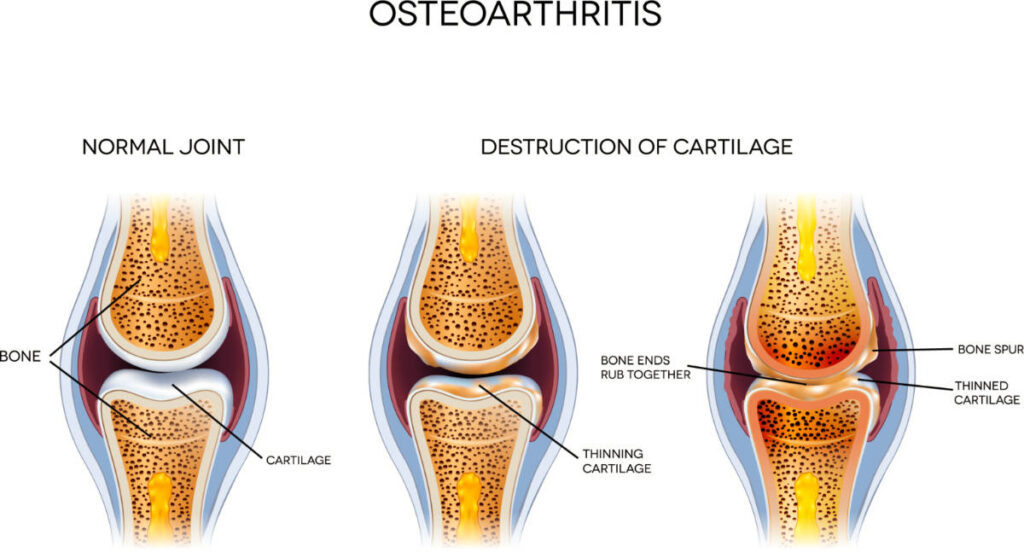Understanding Osteoarthritis, If you or someone you know has been diagnosed with osteoarthritis, you know that it can be hard to manage the pain and discomfort of the condition. Fortunately, there are ways to manage symptoms and maintain a good quality of life. In this blog, we will explore what osteoarthritis is, what its symptoms are, and how to manage them.

We’ll discuss how to adjust lifestyle habits and how to use medications and other treatments to reduce pain and improve mobility. Finally, we’ll look at ways to maintain a good quality of life while living with osteoarthritis.
Understanding Osteoarthritis
Osteoarthritis is a degenerative disease of the joints that most often affects the hands, wrists, hips, and spine. The disease is caused by the wear and tear of the cartilage that covers the bones in the joint. The cartilage can become thin and damaged, which allows the bone to rub against the cartilage and create pain and inflammation. Osteoarthritis can be treated with a variety of treatments, but it often requires surgery to remove the damaged cartilage.
Symptoms and Causes
Osteoarthritis is a condition that affects the joints, specifically the cartilage that cushions the bones. The cartilage can become worn down, thin, and brittle, which can lead to pain and inflammation. There are a number of different causes of osteoarthritis, including genetics, age, injury, and lifestyle choices. Treatment options vary depending on the severity of the condition but may include medication, surgery, physical therapy, and rest.
Diagnosis and Treatment
There is no one-size-fits-all answer to the question of how to treat osteoarthritis, as the condition can vary significantly from person to person. However, there are a few key steps that most people with the condition should take.
The first step is to determine the cause of arthritis. This can be done by consulting with a doctor who can perform a thorough physical exam and review your medical history. Once the cause is identified, the doctor may recommend treatments that are specific to your individual situation.
Some common treatments for osteoarthritis include:
-Weight loss. Obesity is a major risk factor for developing osteoarthritis, and losing weight can help reduce the inflammation and pain caused by the condition.
-Physical activity. Regular exercise can help improve joint function and reduce the risk of developing osteoarthritis.
-Medications. There are a variety of medications available that can help reduce the pain and inflammation associated with osteoarthritis.
-Surgery. Surgery may be necessary in cases where other treatments haven’t worked or in cases where the condition is severe.
Diagnostic
There are a variety of diagnostic tests that can be used to determine if someone has osteoarthritis. These tests can help to determine if the person has the disease, how severe it is, and what type of arthritis they have. Some of the most common diagnostic tests used to assess osteoarthritis include X-rays, MRI scans, and CT scans.
Treatment Options
There are many treatment options for osteoarthritis, depending on the severity of the condition and the person’s preferences. Some people may choose to use medication to help relieve symptoms, while others may choose to undergo surgery. Tests may be necessary to determine which treatment is best for a particular person.
Changes Lifestyle
There are many lifestyle changes that can be made to improve osteoarthritis. These changes can help to reduce pain and improve function. Some of the most common lifestyle changes include:
-Eating a healthy diet. A healthy diet can help to reduce the risk of developing osteoarthritis. This includes eating foods that are high in antioxidants, fiber, and vitamins.
-Exercising regularly. Regular exercise can help to reduce the risk of developing osteoarthritis. Exercise can also improve function and reduce pain.
-Taking medications as prescribed. If medications are prescribed to treat osteoarthritis, it is important to take them as prescribed. This includes taking medications as prescribed by a doctor and not skipping doses.
-Managing stress. Managing stress can be difficult, but it is important to do so if it is causing pain or other symptoms.
-Talking to a doctor. If symptoms continue or worsen, it is important to talk to a doctor. A doctor can help to rule out other causes and determine the best course of action.
Diet
Osteoarthritis is a debilitating joint disease that affects the cartilage that covers the bones in the joint. The disease is caused by the wear and tear of the cartilage, which can lead to pain, stiffness, and a decreased range of motion. The most common form of osteoarthritis is a degenerative joint disease, which affects the knees, hips, and spine.
Osteoarthritis can be treated with a variety of treatments, including medication, physical therapy, and surgery. Some people prefer to follow a diet that helps improve joint health. There are a number of different types of diets that can help improve joint health, including the Mediterranean diet, the vegan diet, and the paleo diet. Each diet has its own benefits and drawbacks, but all of them can help improve joint health. Also, check this Vitality Bowls!
Exercise
There are many different types of exercise that can help people with osteoarthritis. One type of exercise is called aerobic exercise. Aerobic exercise helps improve the function of the lungs and heart, which can help improve the overall function of the body’s muscles. Another type of exercise is called resistance exercise. Resistance exercise helps improve the function of the muscles by increasing their strength.
Stress Management
There are many things that people can do to manage stress. Some people may find that they need to take time for themselves to relax and de-stress. Others may find that they need to set boundaries with their work or social schedule. Some people may find that they need to find a hobby or activity that they can enjoy to take their minds off of things. There are many different ways to manage stress, and it is important to find what works best for you.
Complications of Osteoarthritis
There are a number of complications that can occur with osteoarthritis, including the development of joint pain, stiffness, and limited range of motion. In some cases, arthritis can lead to the loss of joint function, which can make everyday tasks increasingly difficult. Additionally, osteoarthritis can also lead to the development of other health conditions, such as heart disease and stroke.
Joint Damage
Joint damage caused by osteoarthritis can be quite extensive and may require extensive rehabilitation. The pain and inflammation caused by osteoarthritis can make everyday activities difficult, and can significantly reduce the quality of life for those affected.
Joint damage caused by osteoarthritis can be categorized in a number of ways, but the most common type is degenerative. Degenerative joint damage occurs as the cartilage that covers the bones within the joint begins to break down and wear away. This can lead to bone-on-bone contact, which can cause intense pain and inflammation.
Other types of joint damage caused by osteoarthritis include traumatic and infectious. Traumatic joint damage occurs as a result of an external force, such as a fall or a bruise. Infectious joint damage is caused by the presence of bacteria or viruses within the joint, which can lead to inflammation and pain.
Compromised Quality of Life Caused by Osteoarthritis
People with osteoarthritis often face compromised quality of life due to the pain and limitations it causes. The condition can also lead to decreased mobility and reduced ability to perform daily tasks. There are many ways to manage osteoarthritis, but the best way to improve quality of life is to prevent it from happening in the first place.
Preventing osteoarthritis begins with getting regular exercise. This can help to improve overall fitness and reduce the risk of developing the condition in the first place. It is also important to maintain a healthy weight, as obesity can lead to increased levels of inflammation and pain in the joints.
If osteoarthritis is already present, treatments such as medication, surgery, and physical therapy can help to improve the quality of life. In some cases, a combination of treatments may be required to achieve the best results.
Preventing osteoarthritis is the best way to improve the quality of life for people with the condition.
How is Osteoarthritis Treated?
Osteoarthritis (OA) is a common condition that affects the cartilage that covers the bones in the hands, feet, and spine. The cartilage can wear away, causing pain and stiffness. Treatment depends on the severity of the condition. OA can be treated with medications, surgery, or a combination of both. Some people may need to take painkillers for the rest of their lives. Surgery, such as arthroscopy, can help relieve pain and improve function.
Treatment Options
There is no one-size-fits-all answer to treating osteoarthritis, as the best treatment plan will vary depending on the severity of the condition, the person’s age, and other medical factors. However, some common treatment options include:
– Physical therapy: Physical therapy can help improve joint function and reduce pain by teaching patients how to move their joints correctly and exercise.
– Medications: Medications can help reduce pain and inflammation, and may also help improve joint function.
– Surgery: Surgery may be necessary to replace or repair damaged joints.
Medication for Osteoarthritis
Osteoarthritis is a common condition that affects the joints in the body. It is caused by the wear and tear of the cartilage that covers the bones in the joint. The most common symptoms of osteoarthritis are pain and stiffness in the joints. There are many different types of medication that can be used to treat osteoarthritis. Some of the most common medications used to treat osteoarthritis are ibuprofen, Celebrex, and naproxen.
Physical Therapy
Physical therapy can be a very effective treatment for osteoarthritis. Physical therapy can help improve joint function, reduce pain, and improve overall mobility. Physical therapy can also help improve the range of motion and strength.
Physical therapy can be divided into two main categories: conservative and active. Conservative physical therapy involves using exercises and passive treatments such as ice and heat. Active physical therapy involves using exercises and active treatments such as ultrasound and electrical stimulation.
Alternative Treatments
There are many alternative treatments for osteoarthritis, but the most effective and safest treatments are still unknown. Some alternative treatments include:
-Physical therapy: Physical therapy helps to improve joint function and reduce pain.
– massage: Massage can help to improve joint function and reduce pain.
– acupuncture: Acupuncture is a type of treatment that uses small needles to stimulate specific points on the body to relieve pain.
– dietary changes: Some people recommend a diet that is high in antioxidants and low in inflammatory foods.
– stress relief: Stress relief can help to improve joint function and reduce pain.
Acupuncture
There is growing evidence that acupuncture may be effective in treating osteoarthritis. A study published in the Journal of Alternative and Complementary Medicine in 2009 found that acupuncture was as effective as a placebo in relieving pain and improving function in people with osteoarthritis.
A study published in the British Journal of Sports Medicine in 2009 found that acupuncture was as effective as a placebo in relieving pain and improving function in people with osteoarthritis. A study published in the Journal of Alternative and Complementary Medicine in 2009 found that acupuncture was as effective as a placebo in relieving pain and improving function in people with osteoarthritis.
Stem Cell Therapy for Osteoarthritis
Osteoarthritis is a common, chronic condition that affects the joints and can cause pain and disability. The disease is caused by the wear and tear of the cartilage that covers the bones in the joint. Cartilage is a tissue that is responsible for the smooth movement of the joint.
There is no cure for osteoarthritis, but there are treatments that can help relieve the pain and improve the quality of life. One common treatment is stem cell therapy. Stem cells are cells that can grow and divide indefinitely. They are important for repairing damaged tissue.
Stem cell therapy is a relatively new treatment option for osteoarthritis. It is still not clear exactly how stem cell therapy works. However, it is thought that stem cells help the body repair and rebuild damaged tissue.
There are a few ways to perform stem cell therapy for osteoarthritis. One way is to inject stem cells directly into the joint. Another way is to inject the stem cells into the surrounding tissue.
Prolotherapy for Osteoarthritis
Prolotherapy is a treatment that uses injections of a solution of a variety of natural substances, such as autologous blood, hyaluronic acid, and platelet-rich plasma, to stimulate the body’s natural healing process. Prolotherapy has been shown to be effective in treating both acute and chronic osteoarthritis. Prolotherapy can be used to treat both the cartilage and the bone of the joint. It is most commonly used to treat knee pain, but can also be used to treat other joints, such as the shoulder.
Prolotherapy is a relatively new treatment, and much is still unknown about its effectiveness. However, the evidence to date suggests that it is an effective treatment for osteoarthritis. Prolotherapy is not currently approved by the FDA for use in the United States, but it is available through a number of different providers.
Conclusion
Osteoarthritis is an extremely common joint condition that can cause significant pain and discomfort. Fortunately, there are effective ways to manage and reduce symptoms, as well as maintain the quality of life. Those with osteoarthritis should stay active, maintain a healthy weight, get regular checkups, and practice mindful stretching.
Additionally, seeking the advice of a healthcare professional and researching different treatments can help to improve the symptoms of osteoarthritis. By following these tips and taking proactive steps, those affected by osteoarthritis can lead a happy and healthy life. If you find these blogs helpful, please share this with your loved ones and friends. You are also welcome to visit our other related blog for more tips and recommendations.


